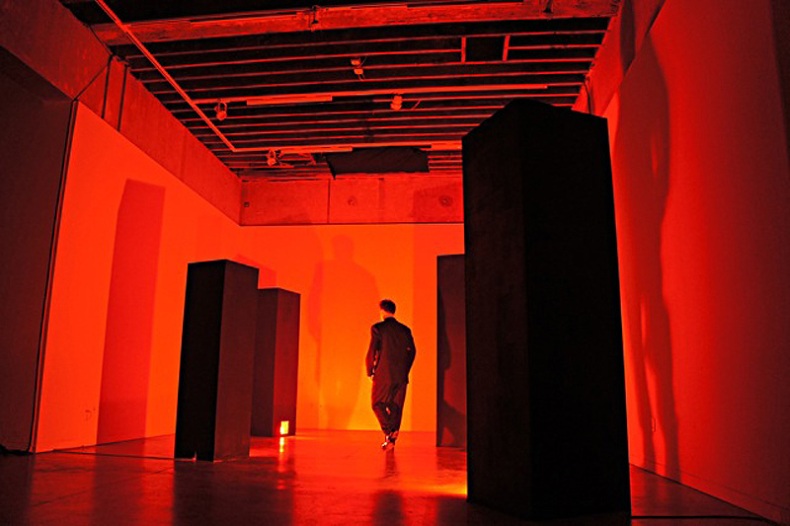Archive for January 2012
Your art is the Best art of All art
“I think artists have a lot more to do with investigating the limits of perception than science does at this time. The basic difference, though, is one of intent. I am more interested in posing questions than answering them. I also think artists are more practical than scientists in that when they find something that works and is useful, they’re quite willing to use it without necessarily knowing why or how it works.”
-James Turrell
“Art exudes the unnecessary. Frank Stella has found it necessary to paint stripes. There is nothing else in his painting.
-Carl Andre
The K-PST performance held at SCI-Arc was undoubtably minimal. A better word might be reductive.
Watching the man walk in a circle around the red-lit obelisks was, perhaps, exhausting, and the anticipation for anything unexpected or surprising was overwhelming. For me, at least, the performance was about the intensity of light and its inhabitation. Others, though, were more skeptical, and were trying to either find reason in metaphor or scientific calculation or they felt relief in debunking the word altogether. It is unwittingly in these reactions that this work, and so much other obscure art, finds its position in the subject of spectacle. In its polar oppositeness to the things in which we typically find more satisfying stimulation (namely, the media), it provides an alternative to everything we thought could capture our attention. Therefore, the general questions and assumptions raised in relation to this art are clearly bit satisfactory in speaking on its terms and set of values. How, then, should we approach this work?
If we consider Turrell’s position, we can look at the artist and his art as a sort of perceptual alternative to the scientist and hard science. Rather than initially considering the work as a whole and its forced similarity to something more relatable in science or metaphor, consider the elements in use: light, floor space, and a person mediating between the two. If we agree that artificial light has only existed for x amount of years and we have therefore not been able to yet exhaust its knowable characteristics, then we could say that the work is potentially speaking about a highly reductive relationship between the human subject and artificial light. The subject’s movements being out of sync with the pitches of the background sound/music could be considered a distraction, in observance of the other reduced yet intensified elements in play.
What’s potentially more interesting, however, is how these elements, in sync or out, can truly frustrate the general public. Rather than focus and delvelop an analysis of the few elements in play, there is the shared opinion that one major element is missing: spectacle.
Spectacle, in this sense, is found in the qualities that do grab our attention, such as suspense, skill, demonstration of labor, and predetermined senses of beauty. Spectacle, we feel, deserves our attention since it fits so well in the constructs of how we feel logic and excitement should be displayed publicly. Spectacle is not often a challenge, and when it is, it is at least a tangible challenge, with a tangible solution.
This work raises more questions than it answers, or better yet, it reduces all those question to one big “what the fuck.” But rather than quit after this feeling of alienation, it is maybe in this sense of otherness that we find a starting point for discussion. What makes this work so hard to focus on? Why do we never see anyone in daily life walk this slow? If it’s the same activity throughout, and if it is to be viewed by the public, why do we not see a progression or shift in the action? Why does this work not have a conclusion, but rather a monotonous repetition? Better yet, why does everything I consider spectacle not have these qualities? Where do these qualities exist where art doesn’t?
The question of whether the artist is brilliant or talented has here been considered limiting, and the question immediately raised is this: How, then, do we judge art, and say that some art is better than other art?
If we say that art should help us evaluate life as we know it (or don’t yet know it), then we should speak about it on those terms. Judgment in the sense of evaluation should, at first, be stifled, in service of a greater picture. The institutionalization of this type of non-spectacle art speaks to those aspects of life that we may not evaluate or consider so deeply.
In the hands of spectacle, these qualities have nearly been exhausted, but it is in this practice that we could learn to step out of the museum and appreciate a sunset.
Written by differance
January 28, 2012 at 10:32 PM
Posted in Uncategorized
Tagged with social agents/social agenda
